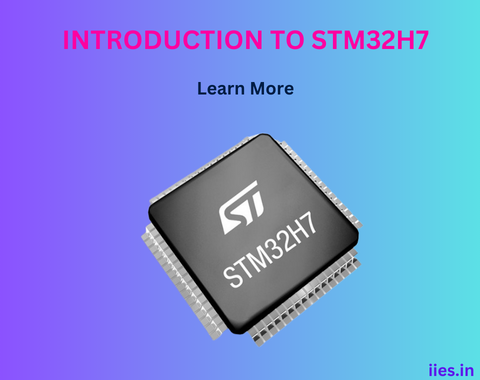
The STM32H7 is a high-performance 32-bit microcontroller that is based on the Arm Cortex-M7 and Cortex-M4 cores. The Cortex-M7 core operates at up to 480 MHz, while the Cortex-M4 core operates at up to 240 MHz ¹. The STM32H7 series is designed to deliver the maximum theoretical performance of the Cortex-M7 and Cortex-M4 cores ¹. The STM32H7 series includes three product line groups: dual-core lines, single-core lines, and value lines .
The dual-core lines consist of Arm Cortex-M7 and Cortex-M4 cores that can respectively run up to 480 MHz and 240 MHz, enabling more processing and application partitioning . The dual-core STM32H7 product lines are available with an embedded SMPS for improved dynamic power efficiency . The single-core lines offer either great performance at 550 MHz or a unique combination of performance and power saving at 280 MHz and 34 µA (typ) in STOP mode . The value lines are cost-effective STM32H7 devices with an embedded 128 Kbytes Flash memory .
The STM32H7 microcontroller is a versatile device that can be used in a wide range of applications. Here are some examples:
1. Richer UIs: The STM32H7 series is designed to deliver the maximum theoretical performance of the Cortex-M7 and Cortex-M4 cores, making it ideal for applications that require high-performance graphics and user interfaces .
2. Predictive maintenance: The STM32H7 devices embedding a crypto/hash processor support security services such as Secure Firmware Install and Secure Boot – Secure Firmware Upgrade enabling the installation of new application codes in a secured manner . This makes it suitable for applications that require secure and reliable data processing.
3. Security: The STM32H7 series leverages ST’s Non-Volatile-Memory (NVM) technology to reach the industry’s highest benchmark scores for Cortex-M-based microcontrollers with up to 1327 DMIPS/ 3224 CoreMark executing from embedded Flash memory . This makes it ideal for applications that require high-performance and secure data processing.
The STM32H7 is a microcontroller, while the Raspberry Pi is a single-board computer. The Raspberry Pi is designed for a wide range of applications, including desktop computing, IoT projects, media centers, and more . It is powered by ARM-based processors, offering higher processing power and capabilities compared to microcontrollers.
On the other hand, the STM32H7 microcontroller is designed to deliver the maximum theoretical performance of the Cortex-M7 and Cortex-M4 cores ¹. It includes three product line groups: dual-core lines, single-core lines, and value lines . The dual-core lines consist of Arm Cortex-M7 and Cortex-M4 cores that can respectively run up to 480 MHz and 240 MHz, enabling more processing and application partitioning . The single-core lines offer either great performance at 550 MHz or a unique combination of performance and power saving at 280 MHz and 34 µA (typ) in STOP mode . The value lines are cost-effective STM32H7 devices with an embedded 128 Kbytes Flash memory.
In terms of performance, the Raspberry Pi is more powerful than the STM32H7 microcontroller. However, the STM32H7 microcontroller is designed for applications that require high-performance graphics and user interfaces, secure and reliable data processing, and high-performance and secure data processing .
The Raspberry Pi is a versatile device that can be used in a wide range of applications. Here are some examples:
1. Learning to code: The Raspberry Pi is an excellent tool for learning programming languages such as Scratch and Python.
2. Media centers: The Raspberry Pi can be used as a media center to stream movies, music, and TV shows .
3. Desktop computing: The Raspberry Pi can be used as a desktop computer for basic computing tasks such as web browsing, word processing, and spreadsheets.
4. Home automation: The Raspberry Pi can be used to create a home automation system that can control lights, temperature, and other home appliances.
5. Robotics: The Raspberry Pi can be used to build robots and other DIY projects.
6. Gaming: The Raspberry Pi can be used to create retro gaming consoles and arcade machines.
7. Internet of Things (IoT): The Raspberry Pi can be used to create IoT devices such as smart thermostats, security cameras, and more.
8. Education: The Raspberry Pi is an excellent tool for teaching computer science and electronics to students .
9. Digital signage: The Raspberry Pi can be used to create digital signage displays for advertising and information purposes .
10. Network monitoring: The Raspberry Pi can be used to monitor network traffic and detect security threats .
High processing power: The STM32H7 series has a dual-core architecture with Cortex-M7 and Cortex-M4 cores that can run up to 480 MHz and 240 MHz, respectively ¹. This enables more processing and application partitioning.
High memory integration: The STM32H7 series incorporates high-speed embedded memories with a dual-bank Flash memory of 2 Mbytes, up to 1 Mbyte of RAM, and an extensive range of enhanced I/Os and peripherals connected to APB buses, AHB buses, 2×32-bit multi-AHB bus matrix, and a multi-layer AXI interconnect supporting internal and external memory access.
Security features: STM32H7 devices embedding a crypto/hash processor support security services such as Secure Firmware Install and Secure Boot – Secure Firmware Upgrade enabling the installation of new application codes in a secured manner .
Pin-to-pin compatibility: The STM32H7 single-core and value lines are pin-to-pin compatible with the STM32F7 series of very high-performance MCUs and STM32F4 series of high-performance MCUs for the most common packages .
Indian Institute of Embedded Systems – IIES